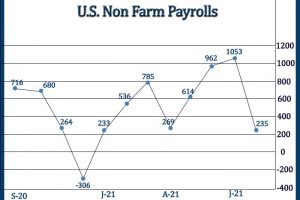U.S. Job Growth Slows Dramatically In August

U.S. job growth fell well short of economic estimates in the month of August, according to a closely watched report released by the Labor Department on Friday.
The Labor Department said non-farm payroll employment rose by 235,000 jobs in August after soaring by an upwardly revised 1.053 million jobs in July.
Economists had expected employment to jump by about 750,000 jobs compared to the spike of 943,000 jobs originally reported for the previous month.
The substantial slowdown in the pace of job growth came as employment in the leisure and hospitality sector was unchanged in August after surging up by 415,000 jobs in July.
The report also showed government employment edged down by 8,000 jobs in August after jumping by 255,000 jobs in the previous month.
Additionally, the Labor Department noted job growth in the professional and business services, transportation and warehousing, private education, and manufacturing sectors was partly offset by a loss of jobs in the retail sector.
“The drop-off in high contact services employment growth suggests that, even though few States have re-imposed restrictions beyond mask mandates, the Delta variant is nevertheless weighing on activity by scaring off customers,” said Paul Ashworth, Chief U.S. Economist at Capital Economics.
Despite the much weaker than expected job growth, the unemployment rate fell to 5.2 percent in August from 5.4 percent in July, matching economist estimates.
The unemployment rate once again dipped to its lowest level since hitting 4.4 percent as the coronavirus pandemic intensified in March of 2020.
The drop in the unemployment rate came as household employment jumped by 509,000 persons, while the labor force rose by just 190,000 persons.
“While the Delta variant is driving renewed virus fear, the labor market recovery seems unlikely to go into reverse,” said Lydia Boussour, Lead US Economist at Oxford Economics. “Still, a slower pace of hiring amid a rapidly spreading Delta variant will warrant a patient tapering approach from the Fed.”
She added, “We believe The FOMC will opt to wait until the November meeting to make a formal tapering announcement, and start reducing asset purchases in December or January, depending on employment progress and inflation developments this fall.”
The report also said average hourly employee earnings increased by $0.17 or 0.6 percent to $30.73 in August. Annual wage growth accelerated to 4.3 percent in August from 4.1 percent in July.
Source: Read Full Article
